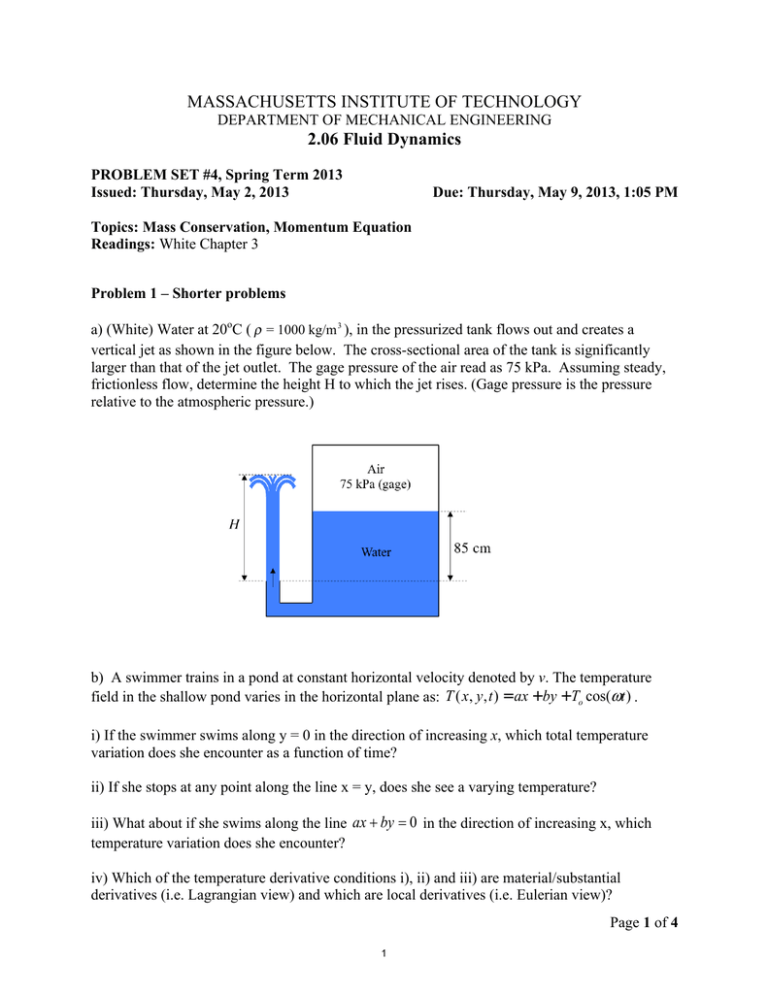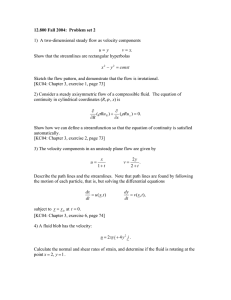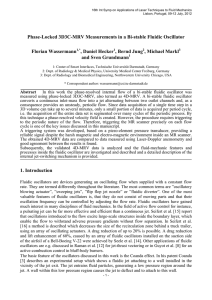Document 13666380
advertisement

MASSACHUSETTS INSTITUTE OF TECHNOLOGY DEPARTMENT OF MECHANICAL ENGINEERING 2.06 Fluid Dynamics PROBLEM SET #4, Spring Term 2013 Issued: Thursday, May 2, 2013 Due: Thursday, May 9, 2013, 1:05 PM Topics: Mass Conservation, Momentum Equation Readings: White Chapter 3 Problem 1 – Shorter problems a) (White) Water at 20oC ( ρ = 1000 kg/m 3 ), in the pressurized tank flows out and creates a vertical jet as shown in the figure below. The cross-sectional area of the tank is significantly larger than that of the jet outlet. The gage pressure of the air read as 75 kPa. Assuming steady, frictionless flow, determine the height H to which the jet rises. (Gage pressure is the pressure relative to the atmospheric pressure.) b) A swimmer trains in a pond at constant horizontal velocity denoted by v. The temperature field in the shallow pond varies in the horizontal plane as: T ( x, y , t ) = ax + by + To cos(ωt ) . i) If the swimmer swims along y = 0 in the direction of increasing x, which total temperature variation does she encounter as a function of time? ii) If she stops at any point along the line x = y, does she see a varying temperature? iii) What about if she swims along the line ax + by = 0 in the direction of increasing x, which temperature variation does she encounter? iv) Which of the temperature derivative conditions i), ii) and iii) are material/substantial derivatives (i.e. Lagrangian view) and which are local derivatives (i.e. Eulerian view)? Page 1 of 4 1 Problem 2 (White) A jet of liquid of density ρ and area A strikes a block and splits into two jets as shown in the figure below. Assume the same velocity V for all three jets. The upper jet exits at an angle θ and area αA. The lower jet is turned 90° degree downward. (Neglect fluid weight.) a) Derive a formula for the force (Fx, Fy) required to support the block against fluid momentum changes. b) Show that Fy = 0 only if α ≥ 0.5. c) Find the values of α and θ for which both Fx and Fy are zero. Problem 3 Water ( ρ = 1000 kg/m 3 ) is flowing through a D = 12 cm diameter pipe, and it is capped by an orifice plated as shown in the figure below. The exit jet is d = 25 mm diameter. The pressure in the pipe at section 1 is 800 kPa (gage). Assume the flow is steady, frictionless, and incompressible. Calculate the force F required to hold the orifice plate. Page 2 of 4 2 Problem 4 a) Consider a steady flow of water through an axisymmetric nozzle. The axial component of velocity increases linearly from vin to vout, i.e. between z = 0 and z = L, it is given by vz = vin+(vout-vin) z/L i. Generate an expression for the radial velocity component r v between z = 0 and z = L. You can ignore the frictional effects on the walls. ii. Find the expressions of the axial and radial accelerations. b) If a fluid flow is compressible, what can you say about the material (substantial/total) derivative of density? What about if the flow field is incompressible? Problem 5 a) Evaluate the divergence ∇.v for the following two-dimensional velocity fields (where α is an arbitrary constant and u and v are the x- and y-components of the velocity): − i) u = α y , v = 0 ii) u = α x , v = α y b) Sketch in the (x, y) plane the streamlines of the two flow fields i) and ii) defined above. c) A two-dimensional velocity field is given by Ky Kx u = − =2 , v 2 2 x +y x + y2 where K is constant. i) Does this field satisfy incompressible continuity? ii) Transform these velocities to polar components. What might the flow represent? Page 3 of 4 3 Problem 6 A rigid can filled with water is spun around the z-axis as shown in the figure above. After a period of time the water spins with the can at a constant angular speed, ω. a) Show that the velocity of the water in the can is V V v = − y î + x ĵ R R € where V is the velocity of the inside surface of the can, R is the inside radius of the can, x and y are the (fixed) horizontal Cartesian coordinates of the point in question as measured from the cylinder axis, and ˆi and ˆj are unit vectors in the x and y directions, respectively. b) For this velocity distribution, use the differential form of the continuity equation, to show that the density of the fluid does not change with time. c) Use the material (substantial/total) derivative to show that the acceleration of the particle is radially inward and of magnitude |v|2/r where r is the distance of the particle from the center of rotation. d) Using the Navier-Stokes equations and your result in "b)" and "c)" derive an expression for the pressure difference between a point on the axis of rotation and a point at a distance r from the axis of rotation. The pressure difference that you have calculated in "d)" is sustained by the curved (in this case circular) streamlines in the fluid. Note that the low pressure region is on the concave side of the streamlines. Pressure gradients in a fluid can me maintained by curved streamlines as well as accelerating and decelerating a fluid along a streamline (recall the Bernoulli equation). e) If V=15 m/s, R=0.04 m, ρ=1000 kg/m3, and Pcenter=105Pa, what is the pressure on the inside surface of the can? Page 4 of 4 4 MIT OpenCourseWare http://ocw.mit.edu 2.06 Fluid Dynamics Spring 2013 For information about citing these materials or our Terms of Use, visit: http://ocw.mit.edu/terms.






